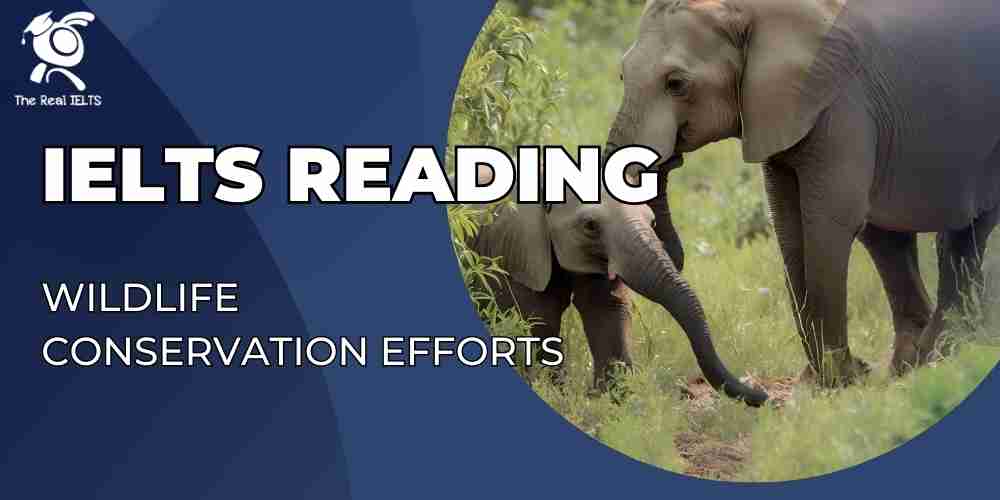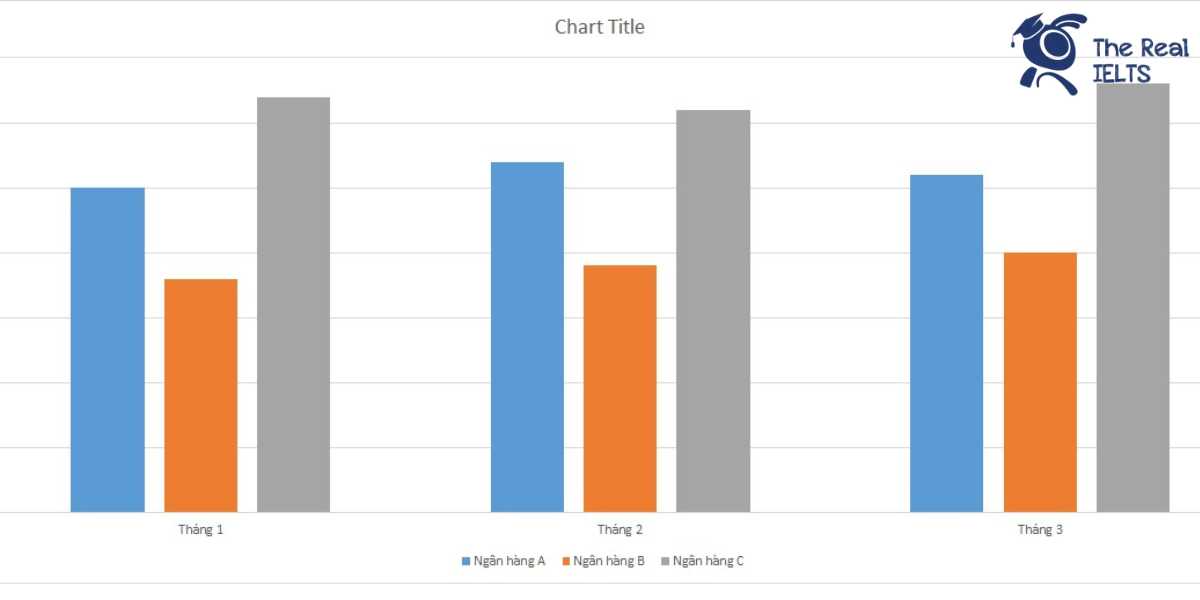IELTS Reading 8: Wildlife Conservation Efforts là chủ đề thuộc chuỗi bài luyện tập 11 dạng bài IELTS Reading và các bài tập luyện tập.
Học lại bài cũ: IELTS Reading 7: The Impact of Agriculture on the Environment.
IELTS Reading: Wildlife Conservation Efforts
Wildlife conservation has become a critical global priority in recent years, as human activity increasingly encroaches upon the natural habitats of various species. Conservation efforts are focused on preserving biodiversity, protecting endangered species, and maintaining ecosystems that support both wildlife and human populations.
One of the primary strategies for wildlife conservation is the establishment of protected areas, such as national parks, wildlife reserves, and marine sanctuaries. These zones are designed to offer a safe haven for wildlife, shielding them from poaching, habitat destruction, and other threats. For example, Yellowstone National Park in the United States and the Serengeti in Tanzania are well-known protected areas that host a wide variety of species. Similarly, marine sanctuaries like the Great Barrier Reef Marine Park in Australia aim to preserve marine biodiversity.
Another important aspect of conservation is the restoration of damaged habitats. Deforestation, pollution, and urbanization have led to the destruction of vital ecosystems. Conservationists are working to replant forests, clean up polluted rivers, and restore wetlands to create environments where wildlife can thrive. In Costa Rica, for instance, reforestation projects have not only helped to increase forest cover but have also provided new habitats for species such as jaguars, monkeys, and tropical birds.
In addition to habitat protection and restoration, the fight against illegal wildlife trade is essential. Poaching and the illegal sale of wildlife products, such as ivory and rhino horn, have driven some species to the brink of extinction. International agreements, like the Convention on International Trade in Endangered Species of Wild Fauna and Flora (CITES), aim to curb this practice by regulating the global trade of wildlife and their products. Additionally, many countries have established strict laws and penalties to deter poaching and trafficking.
One of the more recent approaches to conservation is the use of technology. Drones, camera traps, and satellite tracking systems are being deployed to monitor wildlife populations and poaching activity in real time. For instance, drones are being used in African savannas to monitor herds of elephants and spot potential poaching threats. Camera traps allow scientists to observe elusive species in remote areas, providing valuable data on their behavior and population sizes.
However, while these efforts are commendable, conservation challenges remain. The biggest of these is climate change, which is altering habitats and food sources for many species. Rising temperatures, melting glaciers, and more frequent natural disasters are making it harder for wildlife to survive in their native environments. For example, polar bears in the Arctic are facing a shortage of sea ice, which they rely on for hunting seals. Similarly, coral reefs, home to a vast array of marine life, are being severely impacted by rising ocean temperatures, leading to widespread coral bleaching.
Human-wildlife conflict is another ongoing issue. As human populations grow and expand into wildlife habitats, encounters between people and animals become more frequent, often resulting in harm to both. For instance, elephants in parts of Asia and Africa sometimes raid crops, leading to clashes with farmers who may retaliate against the animals. Conservationists are working to mitigate these conflicts through innovative solutions, such as creating wildlife corridors and implementing early warning systems that alert communities when animals are nearby.
Ultimately, successful wildlife conservation requires global cooperation, long-term planning, and a balance between protecting wildlife and supporting human development. Governments, non-governmental organizations (NGOs), and local communities must work together to create sustainable solutions that ensure the survival of wildlife for future generations.
Question
1. Multiple Choice
Which of the following is a reason why conservationists establish protected areas? A. To restrict tourism in national parks
B. To reduce human-wildlife conflict
C. To provide safe environments for wildlife
D. To monitor climate change effects
2. True/False/Not Given
a. Reforestation in Costa Rica has helped to increase biodiversity in urban areas.
b. Drones are commonly used to track the migration patterns of marine life.
c. CITES is an international agreement to regulate the trade of endangered species.
3. Yes/No/Not Given
a. Do conservationists believe that illegal wildlife trade is the primary reason for species extinction?
b. Is climate change considered the greatest threat to polar bears’ survival?
c. Is human-wildlife conflict more common in rural areas than urban areas?
4. Matching Information
Match the following pieces of information to the relevant paragraph: i. An example of a successful habitat restoration project
ii. An organization that aims to combat illegal wildlife trade
iii. The use of technology to monitor wildlife populations
5. Matching Headings
Choose the correct heading for each paragraph: A. The role of technology in conservation
B. Climate change and its impact on wildlife
C. The importance of protected areas
D. Global efforts to combat illegal wildlife trade
- Paragraph 1: _____
- Paragraph 3: _____
- Paragraph 5: _____
6. Matching Sentence Endings
Complete each sentence by matching the beginning with the correct ending from the list.
- Protected areas like national parks…
- Drones are used in wildlife conservation…
- The Convention on International Trade in Endangered Species (CITES)…
Endings:
a. … to reduce illegal wildlife trade globally.
b. … have been established to protect wildlife from poaching.
c. … monitor and track animal populations in real-time.
7. Sentence Completion
Complete the sentences below using NO MORE THAN THREE WORDS from the passage.
- Reforestation efforts in Costa Rica have helped increase habitats for species like jaguars and __________.
- __________ are an essential tool for scientists studying elusive species.
- Climate change is affecting polar bears by reducing their access to __________.
8. Summary Completion
Complete the summary using words from the text.
Efforts to protect wildlife include creating __________ such as national parks and marine sanctuaries. Additionally, habitat restoration projects aim to reverse __________ caused by urbanization and pollution. One of the biggest challenges faced by wildlife today is __________, which is affecting many species’ natural habitats.
9. Diagram Label Completion
Label the following diagram based on the information from the passage.
Diagram of a Conservation Project:
A. Protected wildlife area: __________
B. Tool used to monitor poaching activity: __________
C. Climate impact on polar bears: __________
10. Short Answer Questions
Answer the following questions using NO MORE THAN THREE WORDS.
- Which area in Australia is known for protecting marine biodiversity?
- What technology is used to observe elusive species in remote areas?
- What is the main threat to coral reefs due to climate change?
11. Table/Flowchart/Note Completion
Complete the table below based on the passage.
| Conservation Efforts | Example | Result |
|---|---|---|
| Protected areas | Yellowstone National Park | Safe habitats for wildlife |
| Habitat restoration | Costa Rica reforestation | Increased forest cover for species |
| Anti-poaching technology | __________ | Monitor elephant herds |
| International agreements | CITES | Reduce __________ |
Answers
1. Multiple Choice
Which of the following is a reason why conservationists establish protected areas?
C. To provide safe environments for wildlife
2. True/False/Not Given
a. False (Reforestation in Costa Rica has helped increase habitats in forests, not urban areas)
b. Not Given (The passage does not specify drones tracking marine life)
c. True (CITES is mentioned as an international agreement regulating the trade of endangered species)
3. Yes/No/Not Given
a. No (Illegal wildlife trade is one reason, but the passage does not say it’s the primary reason for extinction)
b. Yes (The passage mentions polar bears facing a shortage of sea ice due to climate change)
c. Not Given (The passage does not provide information on whether human-wildlife conflict is more common in rural or urban areas)
4. Matching Information
i. Paragraph 3 (An example of habitat restoration: Costa Rica reforestation projects)
ii. Paragraph 4 (CITES is mentioned in the context of combating illegal wildlife trade)
iii. Paragraph 5 (The use of drones and camera traps is discussed)
5. Matching Headings
- C. The importance of protected areas
- A. The role of technology in conservation
- B. Climate change and its impact on wildlife
6. Matching Sentence Endings
- b. have been established to protect wildlife from poaching
- c. monitor and track animal populations in real-time
- a. to reduce illegal wildlife trade globally
7. Sentence Completion
- tropical birds
- Camera traps
- sea ice
8. Summary Completion
Efforts to protect wildlife include creating protected areas such as national parks and marine sanctuaries. Additionally, habitat restoration projects aim to reverse damage caused by urbanization and pollution. One of the biggest challenges faced by wildlife today is climate change, which is affecting many species’ natural habitats.
9. Diagram Label Completion
A. Protected wildlife area: National Parks
B. Tool used to monitor poaching activity: Drones
C. Climate impact on polar bears: Melting sea ice
10. Short Answer Questions
- Great Barrier Reef
- Camera traps
- Rising ocean temperatures
11. Table/Flowchart/Note Completion
| Conservation Efforts | Example | Result |
|---|---|---|
| Protected areas | Yellowstone National Park | Safe habitats for wildlife |
| Habitat restoration | Costa Rica reforestation | Increased forest cover for species |
| Anti-poaching technology | Drones | Monitor elephant herds |
| International agreements | CITES | Reduce illegal trade |















